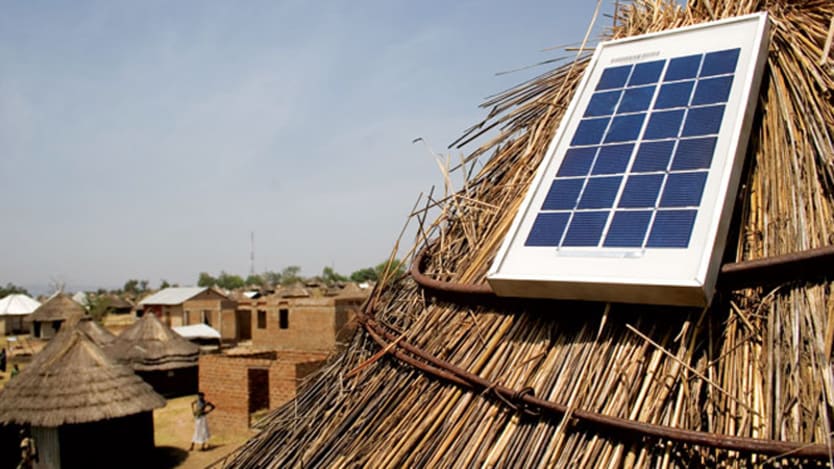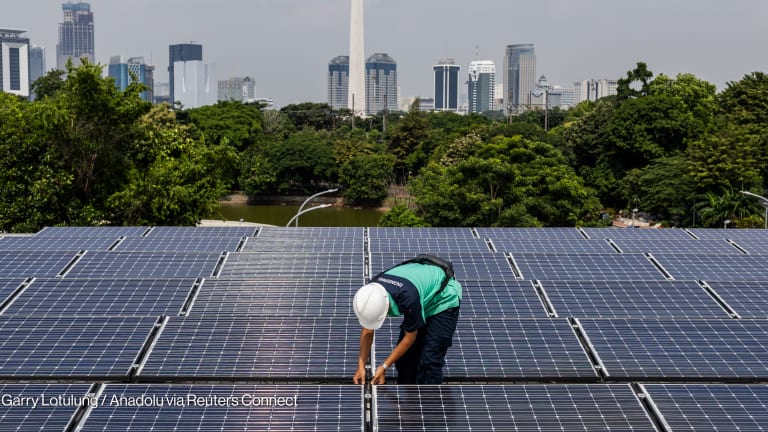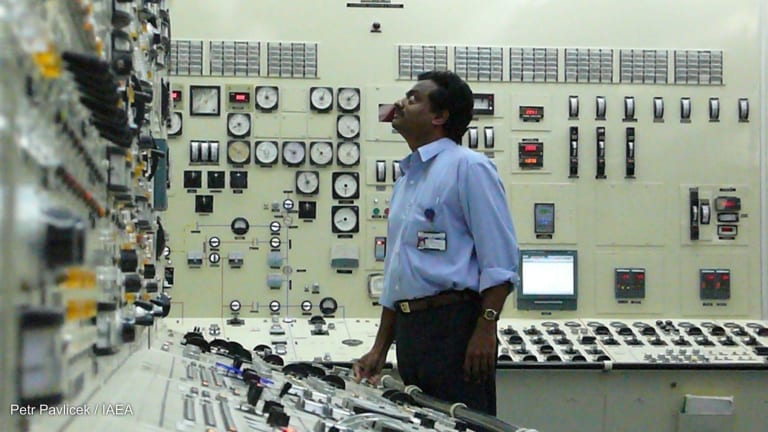
BRATISLAVA, Slovakia — Solar lightbulbs, mini power grids, and batteries could soon supply energy to disadvantaged, rural regions that old-fashioned transmission lines and centralized coal-fired generators will never reach. But while prices of renewables have tumbled, and some say the technology offers lower-income countries the chance to leapfrog over more cumbersome ways of delivering energy, significant challenges remain — particularly around how to finance energy access for the poor.
Most of the world’s energy-poor populations live far from electricity networks. That includes about 57 percent of people in sub-Saharan Africa, or 588 million, who remain without access to electricity according to the International Energy Agency; and just over 1 billion worldwide, the United Nations estimates. The U.N.’s seventh Sustainable Development Goal aims to close that gap by 2030, ensuring universal access to affordable, reliable, and modern energy services.
See more related topics:
► Energy targets off course as clean cooking neglected: Report
► Financing dirty energy: Development's next big political challenge
► Q&A: Countries need 'any kind' of modern energy, says OPEC aid boss
That, however, requires a sharp shift in focus from building new power links to existing grids — which is how most new energy access has been provided until now — to setting up small and nascent off-grid technology powered mostly by solar, hydro, and wind.
“In rural areas of Africa, if you would like to do it in the European fossil fuels way, that means huge public land, huge cables across the continent — and that will never happen,” European Commission Vice-President for Energy Union Maroš Šefčovič told Devex.
“But today, with decentralized grids, if I have a couple of solar panels, we can deliver the energy anywhere.”
With a steady fall in prices over the past decade, mainstream on-grid solar and wind energy is increasingly able to compete with fossil fuel rivals without the need for government support.
A Zambian auction for a 50-megawatt solar power plant in 2016 drew a record low bid for Africa of 6.02 cents per kilowatt-hour, which will be fixed for 25 years. Senegal set another benchmark in April, with two offers at just below 4 euro cents (roughly 5 cents) per kilowatt-hour for a combined 60 megawatts of solar capacity.
“It is by far the cheapest way to provide energy,” said Alzbeta Klein, director and global head for climate business at the International Finance Corporation, a World Bank Group member that advised the Zambian and Senegalese governments on the auctions.
“We’re talking double digits, in cents per kilowatt-hour, for [fossil fuel] generators,” said Klein.
For now, off-grid solar energy solutions, which can run in remote areas without power networks and storage, and which can hold electricity for when the weather wanes or demand rises, remain frontier and niche technologies — too risky for most commercial banks that tend to shy away from emerging markets anyway, Klein said.
But so were on-grid solar and wind farms 10-15 years ago, she added.
“The technology is still relatively young, and bankers need to learn how to finance that, just like bankers learned to finance solar and wind over the past decade.”
Easier said than done
Solar lights already help poor and rural households in Africa save money, accounting for around 2 percent of annual income, compared to 10 percent for kerosene, torches or candles, according to a 2016 report prepared for the United Kingdom’s Department for International Development. The cost of solar lights has already fallen, from $25 at its cheapest in 2008 to around $5 at the end of 2016, according to SolarAid, a charity that sets up solar lights in rural areas.
“There’s a pure and simple finance gap between what the poorest people can afford and what they want.”
— John Keane, CEO at SolarAidIt’s a good start, but still a long way from helping reach universal energy access in the next 12 years, as set out in the SDGs, stressed John Keane, SolarAid’s chief executive officer.
“It’s fantastic that over the last 10 years a whole market has been created from scratch, which is designed to provide relatively low-cost, affordable solutions to basic forms of energy — lighting, home systems, and chargers,” Keane said.
“But there’s a pure and simple finance gap between what the poorest people can afford and what they want.”
Even when solar lights are installed, they generally only work for a few hours a day. Most homes still lack the power to plug in fridges and other appliances, let alone power rural businesses, he added.
It’s also hard to drum up investor interest in such projects, especially without strong incentives and policy support from governments.
Renewable energy equipment can also be subject to taxes, sometimes suddenly — as Zambia recently did with a 15 percent duty on the import of solar lights and 16 percent VAT, according to SolarAid. In Kenya, the sector has been hampered by confusion over the past five years about whether solar lights, water heaters, batteries, and other equipment are subject to 16 percent VAT.
Also dissuading investment is the fact that governments in lower-income countries often subsidize the energy prices so poorer customers can afford it.
For Rift Valley Energy, which sells hydropower in Tanzania’s rural Southern Highlands, the key was to make up for artificially low, fixed power tariffs by also selling energy into the national grid at a higher price. The Zimbabwe-based company built the 4 MW plant with backing from the ACP-EU Energy Facility, which co-finances sustainable energy projects in African, Caribbean, and Pacific countries.
“Supplying the majority of our electricity to the national utility and to industrial customers [mainly the local tea industry] as back-up power is our main source of income,” said Franz Kottulinsky, Rift Valley Energy’s director and co-founder.
That then allows the company to supply around 3,000 rural customers with affordable, fixed-rate energy.
“However, in the long term, we will need cost-reflective rural tariffs to make our electrification business economically sustainable and more independent from donor support.”
Rift Valley Energy’s sister company, a large tea producer in Tanzania, decided to build the hydropower plant a decade ago to supply its own factory with constant power, and avoid relying on the national grid that is susceptible to blackouts. The ACP-EU Energy Facility provided grants, on the condition that it also supply nearby communities.
It now sells energy 24 hours a day to 32 villages — enough to power small- and medium-enterprises such as tea and wood processing businesses, rather than just household lighting and mobile phone chargers.
Beyond the grid
Cracking universal energy access will require much larger amounts of energy generation far from grid networks.
The number of people without electricity worldwide fell from 1.7 billion in 2000 to 1.1 billion in 2016, according to IEA. It is expected to reach 674 million by 2030, including universal access in India “well before then.” In sub-Saharan Africa, however, the number in 2030 is still pegged at around 600 million, mostly in rural areas. While grid connection remains the cheapest way to boost electricity access in urban areas, decentralized off-grid and mini-grid projects will be the most cost-effective solutions for more than 70 percent of those living in rural areas, according to IEA.
“If you haven’t got electricity access in rural areas, you’re tying your hands behind your back in trying to solve all the SDGs,”
— John Keane, CEO at SolarAidBroadly, energy access is attracting a lot of good public and private money, but it is still too heavily focused on big, centralized power projects — and largely fossil fuel-fired — that support industrialization, said Sasanka Thilakasiri, senior policy adviser on climate change and energy at Oxfam America. Coal provided 45 percent of new energy access between 2000 and 2016, followed by natural gas with 19 percent, and oil with 7 percent, according to IEA.
“A lot of institutions are not financing off-grid to the extent that it needs to,” Thilakasiri said.
“There’s a conflation between energy industrialization with energy for access … A lot of the centralized power plants are taking up a lot of the bandwidth.”
Finance ministries like them because they underpin headline-grabbing projects such as new factories, rather than small-scale household improvements, he said.
On the plus side, some counter that the lack of a long-established, centralized energy system can make it easier to set up clean technology in rural areas than to replace decades-old coal, gas, and nuclear power plants with small and intermittent renewables.
“In a way, [lower-income countries] have the advantage of not having to repeat what we more developed countries have done, in terms of going through these levels of development from traditional energy to modern, digitalized energy,” Vazil Húdak, vice president at the European Investment Bank and former Slovakian economy minister, told the GLOBSEC conference in Bratislava this month.
“[They] are coming to this phase at a time when technologies are cheaper, much more advanced … they have a lower cost of financing,” said Húdak.
Many argue this fall in costs for renewable technologies, combined with the broader shift toward lower emitting and more efficient energy use in response to climate change, will gradually lower the risks that now keep commercial banks and others away.
But it still needs a clear shove from governments — including with the use of subsidies for household energy, mini-grids, and other infrastructure needed to meet the SDG for energy access, which can help meet the other 16 goals too, Keane said.
“If you haven’t got electricity access in rural areas, you’re tying your hands behind your back in trying to solve all the SDGs,” he said.
“Without electricity, it’s hard to fight poverty, it’s hard to improve your quality of life. Without electricity, all these SDGs just aren’t serious.”








